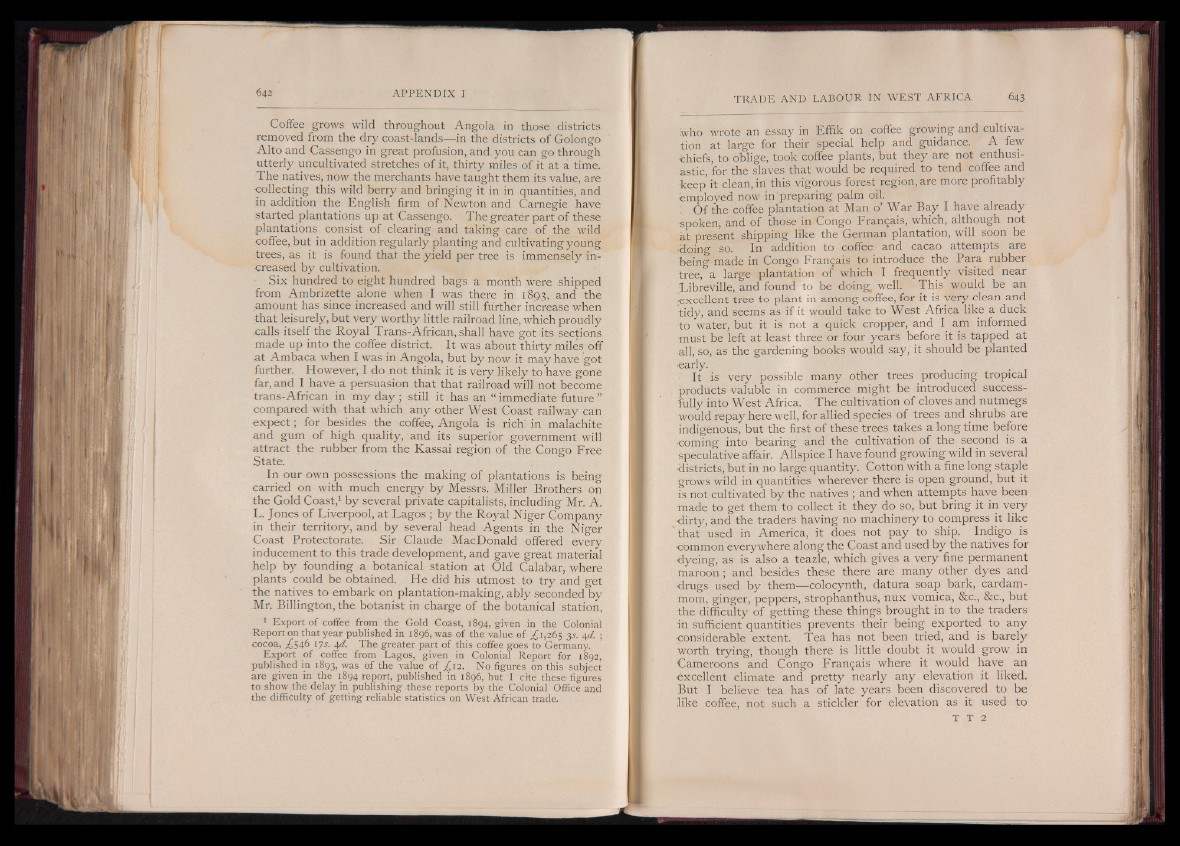
Coffee grows wild throughout Angola in those districts
removed from the dry coast-lands— in the districts of Golongo
Alto and Cassengo in great profusion, and. you can go through
utterly uncultivated stretches of it, thirty miles of it at a time.
The natives, now the merchants have taught them its value, are
collecting this wild berry and bringing it in in quantities, and
in addition the English firm of Newton and Carnegie have
started plantations up at Cassengo. The greater part of these
plantations consist of clearing and taking care of the wild
coffee, but in addition regularly planting and cultivating young
trees, as it is found that the yield per tree is immensely increased
by cultivation.
Six hundred to eight hundred bags a month were shipped
from Ambrizette alone when I was there in 1893, and the
amount has since increased and will still further increase when
■that leisurely, but very worthy little railroad line, which proudly
calls itself the Royal Trans-African, shall have got its sections
made up into the coffee district. It was about thirty miles off
at Ambaca when I was in Angola, but by now it may have got
further. However, I do not think it is very likely to have gone
far, and I have a persuasion that that railroad will not become
trans-African in my d a y ; still it has an “ immediate future ”
compared with that which any other West Coast railway can
e xpe c t; for besides the coffee, Angola is rich: in malachite
and gum of high quality, and its superior government will
attract the rubber from the Kassai region of the Congo Free
State.
In our own possessions the making of plantations is being
carried on with much energy by Messrs. Miller Brothers on
the Gold Coast,1 by several private capitalists, including Mr. A.
L. Jones of Liverpool, at Lagos ; by the Royal Niger Company
in their territory, and by several head Agents in the Niger
Coast Protectorate. Sir Claude MacDonald offered every
inducement to this trade development, and gave great material
help by founding a botanical station at Old Calabar, where
plants could be obtained. He did his utmost to try and get
the natives to embark on plantation-making, ably seconded by
Mr. Billington, the botanist in charge of the botanical station,
1 Export of coffee from the Gold Coast, 1894, given in the Colonial
Report on that year published in 1896, was of the value of ¿1,265 3-r- 4d. ;
cocoa, ¿546 17s. 4d. The greater part of this coffee goes to Germany.
Export of coffee from Lagos, given in Colonial Report for 1892,
published in 1893, was of the value of ¿ 1 2 . No figures on this subject
are given in the 18 9 4 report, published in 1896, but I cite these-figures
to show the delay in publishing these reports by the Colonial Office and
the difficulty of getting reliable statistics on West African trade.
who wrote an essay in Effik on coffee growing and cultivation
at large for their special help and guidance. A few
chiefs, to oblige, took coffee plants, but they are not enthusiastic,
for the slaves that would be required to tend coffee and
keep it clean, in this vigorous forest region, are more profitably
employed now in'preparing palm oil.
Of the coffee plantation at Man o’ War Bay I have already
•spoken, and of those in Congo Français, which, although not
at present shipping like the German plantation, will soon be
■doing so. In addition to coffee and cacao attempts are
being made in Congo Français to introduce the Para rubber
tree, a large plantation of which I frequently visited near
Libreville, and found to be doing, well. This would be an
excellent tree to plant in among coffee, for it is very clean and
tidy, and seems as if it would take to West Africa like a duck
to water, but it is not a quick cropper, and I am informed
must be left at least three or four years before it is tapped at
all, so, as the gardening books would say, it should be planted
■early.
It is very possible many other trees producing tropical
products valuble in commerce might be introduced successfully
into West Africa. The cultivation of cloves and nutmegs
would repay here well, for allied species of trees and shrubs are
indigenous, but the first of these trees takes a long time before
coming into bearing and the cultivation of the second is a
speculative affair. Allspice I have found growing wild in several
■districts, but in no large quantity. Cotton with a fine long staple
grows wild in quantities wherever there is open ground, but it
is not cultivated by the natives ; and when attempts have been
made to get them to collect it they do so, but bring it in very
dirty, and the traders having no machinery to compress it like
that used in America, it does not pay to ship. Indigo is
Common everywhere along the Coast and used by the natives for
dyeing, as is also a teazle, which gives a very fine permanent
maroon; and besides these there are many other dyes and
drugs used by them— colocynth, datura soap bark, cardam-
mom, ginger, peppers, strophanthus, nux vomica, &c., &c., but
the difficulty of getting these things brought in to the traders
in sufficient quantities prevents their being exported to any
considerable extent. Tea has not been tried, and is barely
worth trying, though there is little doubt it would grow in
Cameroons and Congo Français where it would have an
excellent climate and pretty nearly any elevation it liked.
But I believe tea has of late years been, discovered to be
like coffee, not such a stickler for elevation as it used to